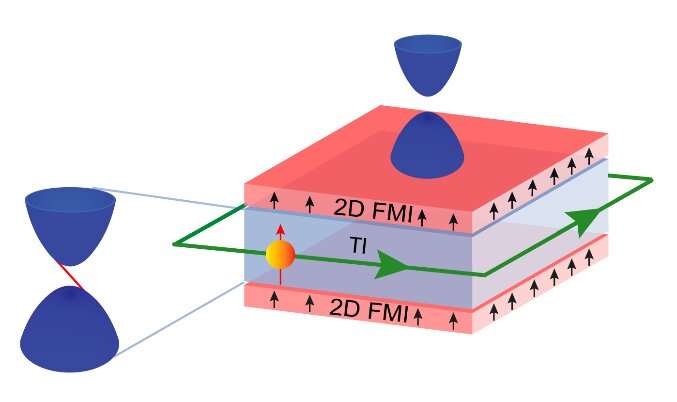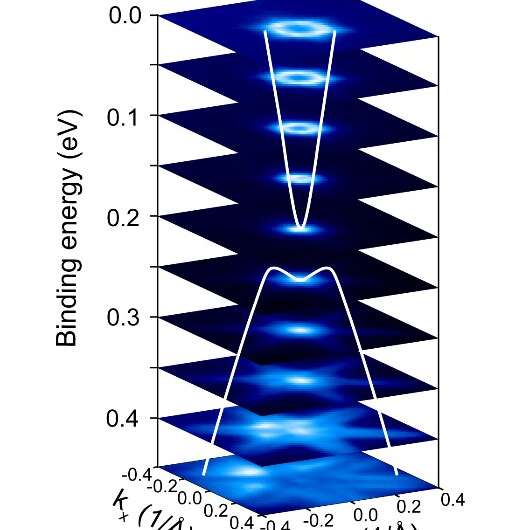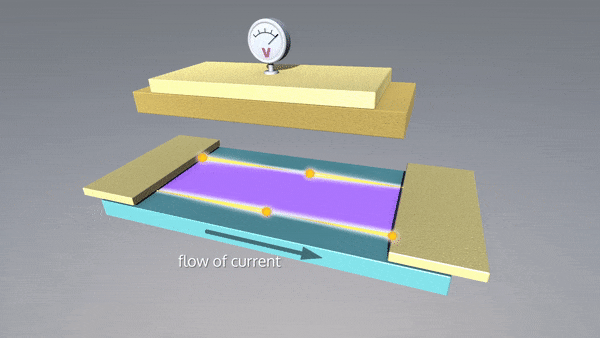Making a 'sandwich' out of magnets and topological insulators shows potential for lossless electronics

A Monash University-led research team has discovered that a structure comprising an ultra-thin topological insulator sandwiched between two 2D ferromagnetic insulators becomes a large-bandgap quantum anomalous Hall insulator.
Such a heterostructure provides an avenue towards viable ultra-low energy future electronics, or even topological photovoltaics.
Topological insulator: The filling in the sandwich
In the researchers' new heterostructure, a ferromagnetic material forms the "bread" of the sandwich, while a topological insulator (ie, a material displaying nontrivial topology) takes the place of the "filling."
Combining magnetism and nontrivial band topology gives rise to quantum anomalous Hall (QAH) insulators, as well as exotic quantum phases such as the QAH effect where current flows without dissipation along quantized edge states.
Inducing magnetic order in topological insulators via proximity to a magnetic material offers a promising pathway towards achieving QAH effect at higher temperatures (approaching or exceeding room temperature) for lossless transport applications.
One promising architecture involves a sandwich structure comprising two single layers of MnBi2Te4 (a 2D ferromagnetic insulator) either side of ultra-thin Bi2Te3 in the middle (a topological insulator). This structure has been predicted to yield a robust QAH insulator phase with a bandgap well above the thermal energy available at room temperature (25 meV).
The new Monash-led study demonstrated the growth of a MnBi2Te4 / Bi2Te3 /MnBi2Te4 heterostructure via molecular beam epitaxy, and probed the structure's electronic structure using angle resolved photoelectron spectroscopy.
"We observed strong, hexagonally-warped massive Dirac fermions and a bandgap of 75 meV," says lead author Monash Ph.D. candidate Qile Li.

The magnetic origin of the gap was confirmed by the observing the bandgap vanishing above the Curie temperature, as well as broken time-reversal symmetry and the exchange-Rashba effect, in excellent agreement with density functional theory calculations.
"These findings provide insights into magnetic proximity effects in topological insulators, which will move lossless transport in topological insulators towards higher temperature," says Monash group leader and lead author Dr. Mark Edmonds.
How it works
The 2D MnBi2Te4 ferromagnets induce magnetic order (i.e., an exchange interaction with the 2D Dirac electrons) in the ultra-thin topological insulator Bi2Te3 via magnetic proximity.
This creates a large magnetic gap, with the heterostructure becoming a quantum anomalous Hall (QAH) insulator, such that the material becomes metallic (i.e., electrically conducting) along its one-dimensional edges, whilst remaining electrically insulating in its interior. The almost-zero resistance along the 1D edges of the QAH insulator are what make it such a promising pathway towards next-generation, low-energy electronics.
To date, several strategies have been used to realize the QAH effect, such as introducing dilute amounts of magnetic dopants into ultrathin films of 3D topological insulators. However, introducing magnetic dopants into the crystal lattice can be challenging and results in magnetic disorder, which greatly suppresses the temperature at which the QAH effect can be observed and limits future applications.
Rather than incorporating 3D transition metals into the crystal lattice, a more advantageous strategy is to place two ferromagnetic materials on the top and bottom surfaces of a 3D topological insulator. This breaks time-reversal symmetry in the topological insulator with magnetic order, and thereby opens a bandgap in the surface state of the topological insulator and gives rise to a QAH insulator.
Making the right kind of sandwich
Yet, inducing sufficient magnetic order to open a sizable gap via magnetic proximity effects is challenging due to the undesired influence of the abrupt interface potential that arises due to lattice mismatch between the magnetic materials and topological insulator.

"To minimize the interface potential when inducing magnetic order via proximity, we needed to find a 2D ferromagnet that possessed similar chemical and structural properties to the 3D topological insulator" says Qile Li, who is also a Ph.D. student with the Australian Research Council Center for Excellence in Future Low-Energy Electronic Technologies (FLEET).
"This way, instead of an abrupt interface potential, there is a magnetic extension of the topological surface state into the magnetic layer. This strong interaction results in a significant exchange splitting in the topological surface state of the thin film and opens a large gap," says Li.
A single-septuple layer of the intrinsic magnetic topological insulator MnBi2Te4 is particularly promising, as it is a ferromagnetic insulator with a Curie temperature of 20 K.
"More importantly, this setup is structurally very similar to the well-known 3D topological insulator Bi2Te3, with a lattice mismatch of only 1%" says Dr. Mark Edmonds, who is an associate investigator in FLEET.
The research team traveled to the Advanced Light Source part of the Lawrence Berkeley National Laboratory in Berkeley, U.S., where they grew the ferromagnet/topological/ferromagnet heterostructures and investigated their electronic band structure in collaboration with beamline staff scientist Dr. Sung-Kwan Mo.
"Although we cannot directly observe the QAH effect using angle-resolved photoemission spectroscopy (ARPES), we could use this technique to probe the size of the bandgap opening, and then confirm it is magnetic in origin," says Dr. Edmonds.
"By using angle-resolved photoemission we could also probe the hexagonal warping in the surface state. It turns out, the strength of the warping in the Dirac fermions in our heterostructure is almost twice as large as in Bi2Te3," says Dr. Edmonds
The research team was also able to confirm the electronic structure, gap size and the temperature at which this MnBi2Te4/Bi2Te3/MnBi2Te4 heterostructure is likely to support the QHE effect by combining experimental ARPES observations with magnetic measurements to determine the Curie temperature (performed by FLEET associate investigator Dr. David Cortie at the University of Wollongong) and first-principles density functional theory calculations performed by the group of Dr. Shengyuan Yang (Singapore University of Technology and Design).
The growth for this heterostructure was initially found in Edmonds Electronic Structure Laboratory at Monash University. Afterward, the heterostructure films were grown and characterized using ARPES measurements at the Advanced Light Source (Lawrence Berkeley National Laboratory) in California.
The study, "Large magnetic gap in a designer ferromagnet–topological insulator–ferromagnet heterostructure," was published in Advanced Materials in March 2022.
More information: Qile Li et al, Large Magnetic Gap in a Designer Ferromagnet–Topological Insulator–Ferromagnet Heterostructure, Advanced Materials (2022). DOI: 10.1002/adma.202107520



















